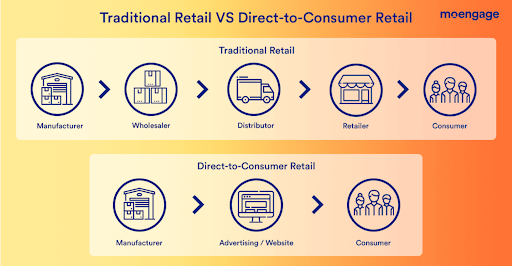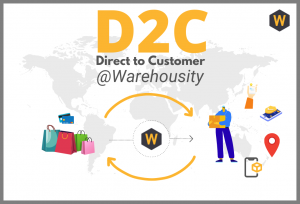How a D2C Ecommerce Agency Can Help You Expand to Global Markets
Discovering the Prospective of D2C Ecommerce: A Comprehensive Guide for Services
The D2C ecommerce version presents a considerable shift in just how brand names engage with consumers. It allows companies to bypass traditional retail channels, fostering deeper links and potentially increased profit margins. This approach is not without its complexities. Recognizing the subtleties of D2C ecommerce is necessary for brand names intending to thrive. What strategies can they take on to navigate this evolving landscape properly? The answers may redefine their company approaches.
Understanding the D2C Ecommerce Model

Key Advantages of D2C Ecommerce for Brands
The D2C ecommerce design offers brand names considerable benefits, specifically concerning enhanced profit margins. By getting rid of intermediaries, firms can keep a larger share of sales revenue. In addition, this direct partnership with consumers cultivates enhanced brand commitment, encouraging repeat acquisitions and lasting involvement.
Enhanced Revenue Margins

Improved Brand Loyalty
Structure on the financial advantages of D2C ecommerce, improved brand commitment becomes another necessary advantage for firms involving straight with customers. By establishing a straight link, brands can promote deeper relationships with their clients, getting insights into preferences and actions. This straight interaction enables more individualized marketing approaches, which reverberate highly with customers. In addition, brand names have the opportunity to manage their messaging and customer experience, strengthening brand name values and developing depend on. When clients really feel a personal connection, they are much more most likely to return, advocate for the brand name, and join area engagement. Eventually, boosted brand name commitment not only drives repeat acquisitions however likewise grows a passionate client base, further strengthening a brand name's placement on the market.
Difficulties Dealt With by D2C Brands
D2C brand names experience a number of substantial challenges that can affect their success. Stock monitoring issues can bring about equip shortages or excess, complicating operations and consumer complete satisfaction. Furthermore, advertising budget restrictions commonly restrict the capability to efficiently reach and engage target market.
Stock Administration Issues
Effective supply management presents a powerful difficulty for lots of brands running in the direct-to-consumer (D2C) room. These brand names frequently come to grips with fluctuating need, which can result in overstock or stockouts, eventually impacting consumer complete satisfaction and profits. In addition, the absence of advanced supply monitoring systems can cause disparities in between actual supply degrees and reported data, making complex order gratification. The varied array of items D2C brand names generally supply likewise makes complex stock monitoring, as variants in styles, colors, and dimensions call for more precise oversight. In addition, several D2C services may have problem with limited warehousing capabilities, causing inefficient use of area and sources. As a result, effective stock monitoring stays a vital hurdle for D2C brands going for sustainable growth and functional effectiveness.
Advertising Budget Plan Constraints
Steering advertising and marketing spending plan constraints is a significant obstacle for many direct-to-consumer (D2C) brands. Minimal funds often limit these companies' ability to purchase all-inclusive advertising strategies, resulting in reduced exposure in an open market. D2C brand names frequently come to grips with the demand to make the most of roi (ROI) while targeting particular audiences effectively. This challenge is aggravated by increasing costs in electronic marketing and the requirement to assign funds across numerous channels, including social media sites, online search engine, and e-mail marketing. Consequently, many D2C brand names have to introduce cost-efficient advertising solutions, leveraging organic growth strategies and influencer collaborations. Inevitably, efficiently steering these spending plan restrictions is vital for sustaining development and attaining long-lasting profitability in the developing ecommerce landscape.
Techniques for Building an Effective D2C Ecommerce Business
As customers increasingly look for straight connections with brand names, developing a successful D2C ecommerce organization requires a calculated strategy that focuses on client interaction and trust. One efficient method is to produce engaging brand name narratives that resonate with target audiences, fostering psychological links. Utilizing social media sites systems can boost visibility and assist in two-way communication, permitting brand names to involve straight with customers.Moreover, personalized experiences via customized advertising and marketing efforts can substantially boost customer retention and commitment. Executing commitment programs and supplying exclusive offers can better incentivize repeat purchases.Streamlining the buying procedure is crucial, making sure an easy to use user interface that improves the purchasing experience. Furthermore, transparent interaction concerning my site delivery and returns constructs count on and urges customer confidence.Finally, proactively seeking customer feedback and replying to it shows a dedication to renovation and i was reading this customer fulfillment, critical components in the affordable D2C landscape.
Leveraging Modern Technology for Improved Consumer Experience
In today's competitive D2C ecommerce landscape, innovation plays a pivotal function fit consumer experiences. Businesses significantly make use of innovative devices such as artificial intelligence, chatbots, and individualized algorithms to improve communications and enhance the purchasing procedure. By incorporating these innovations, brands can give customized item referrals based on individual choices and shopping actions, promoting a more engaging experience.Moreover, responsive website styles and mobile applications ensure that clients can access services flawlessly across different tools. Improved payment options, consisting of one-click check outs and electronic pocketbooks, even more streamline transactions, making it less complicated for customers to make purchases.Data analytics also allows companies to gather insights into consumer behavior, enabling constant enhancement of solutions and offerings. In general, leveraging technology not just improves consumer satisfaction but also cultivates commitment, inevitably driving long-lasting success in the D2C ecommerce market.
Advertising Techniques to Drive D2C Sales
How can brands successfully capture the interest of consumers in a saturated market? To flourish in the direct-to-consumer (D2C) landscape, brands have to utilize targeted advertising tactics. Utilizing social media sites platforms, brands can engage consumers via interactive content, influencer partnerships, and user-generated blog posts. Individualized e-mail projects can also foster a feeling of link, supplying customized promotions based on consumer behavior and preferences.Moreover, narration plays an essential function in distinguishing a brand name's narrative, making it relatable and unforgettable. Brand names must buy seo (SEO) to boost presence, guaranteeing their products are quickly visible online. Furthermore, leveraging information analytics enables organizations to improve their marketing strategies and comprehend consumer fads much better. Ultimately, a multi-channel technique view it that combines imagination with data-driven insights can considerably improve D2C sales, enabling brands to stand apart in a congested marketplace.
Future Patterns in D2C Ecommerce
With the quick development of innovation and customer choices, the future of D2C ecommerce is poised for significant transformation. Emerging fads suggest a change towards hyper-personalization, where brand names utilize information analytics to tailor offerings to individual consumer needs. This modification improves consumer experiences, promoting loyalty and engagement.Moreover, sustainability is becoming an important aspect, with customers progressively favoring brand names that prioritize green practices - D2C Ecommerce Agency. Companies are expected to adopt transparent supply chains and sustainable products to meet this demand.The assimilation of man-made knowledge and augmented fact will additionally change the buying experience, permitting consumers to envision items in their atmospheres before acquisition. Furthermore, social commerce is expected to grow, as systems like Instagram and TikTok promote smooth buying experiences straight within social media.These patterns collectively indicate a dynamic future for D2C ecommerce, emphasizing customer-centric techniques and ingenious modern technologies that redefine consumer interactions
Often Asked Inquiries
What Industries Advantage Most From D2C Ecommerce?
The existing question highlights markets that flourish with direct-to-consumer (D2C) ecommerce. Remarkably, fashion, beauty, electronics, and food sectors take advantage of D2C versions to boost brand name commitment, boost customer partnerships, and maximize profit margins properly.
Just How Do Shipping Prices Affect D2C Pricing Techniques?
Shipping costs considerably influence D2C pricing techniques. Services should stabilize these expenses with competitive rates, considering consumer expectations and profit margins. Efficient monitoring of shipping can enhance customer fulfillment and drive sales in direct-to-consumer models.
What Settlement Options Should D2C Organizations Deal?
D2C businesses need to provide varied repayment options, including credit/debit cards, digital wallets, and get currently, pay later on solutions. This selection enhances client ease, boosts conversion prices, and provides to various consumer preferences in the online shopping landscape.
Just How Can D2C Brands Manage Customer Returns Successfully?
D2C brands can manage client returns effectively by executing user-friendly return plans, supplying pre-paid shipping tags, and making sure punctual reimbursements (D2C Ecommerce Agency). Clear communication and structured processes improve client complete satisfaction and urge repeat organization
What Lawful Considerations Exist for D2C Ecommerce Workflow?
Lawful considerations for D2C ecommerce procedures include conformity with customer security laws, data privacy laws, intellectual residential property legal rights, and taxes requirements. Brands need to browse these complexities to prevent lawful risks and ensure smooth procedures. By getting rid of intermediaries, D2C brand names can supply affordable prices and foster a more intimate relationship with their customers.The D2C design is defined by its dependence on digital platforms, enabling brands to use social media, on the internet industries, and their very own sites to involve with customers straight. D2C ecommerce facilitates the collection of useful client information, making it possible for brand names to customize their offerings and marketing approaches successfully, inevitably driving sales and boosting margins. In addition, brand names have the possibility to regulate their messaging and consumer experience, enhancing brand values and developing trust fund. As customers increasingly look for direct connections with brands, establishing a successful D2C ecommerce business calls for a critical technique that focuses on customer involvement and count on. D2C brands can manage consumer returns properly by implementing straightforward return plans, supplying pre paid delivery tags, and guaranteeing punctual reimbursements.